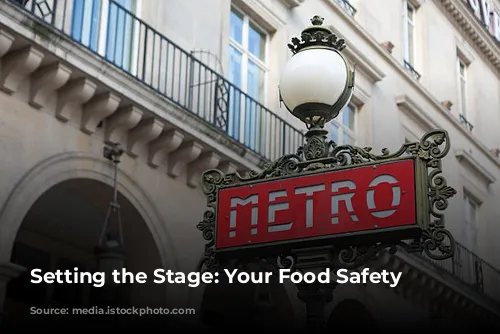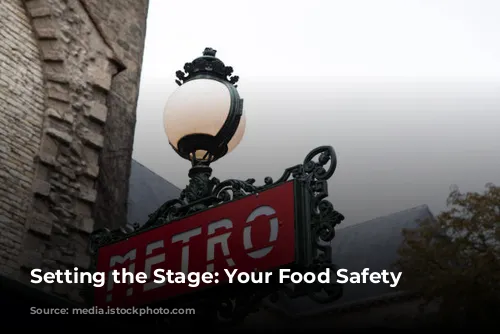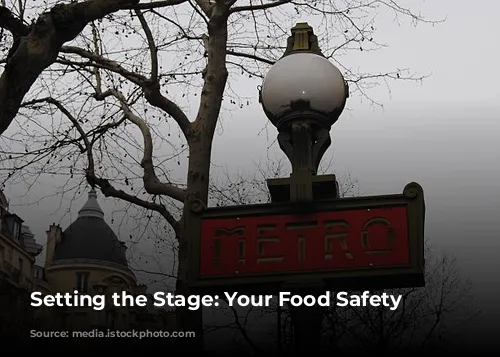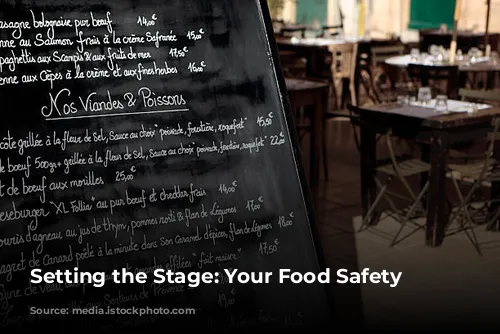This guide will help you navigate the crucial world of food hygiene practices, a vital aspect of running a successful food establishment. We’ll break down key regulations, equipment guidelines, and essential hygiene procedures to ensure your business maintains a safe and healthy environment.
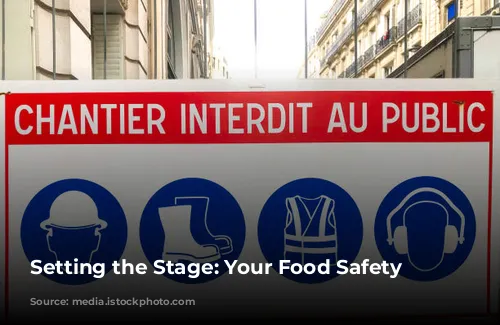
Layout and Equipment: Building a Safe Foundation
Proper layout and appropriate equipment are crucial for maintaining a safe and hygienic food environment. The space you operate in should be meticulously planned to prevent contamination and ensure easy cleaning. Here’s what you need to consider:
- Organized Premises: Designate dedicated areas for different tasks, like preparing food, washing dishes, and storing supplies. This ensures a smooth workflow and prevents cross-contamination.
- Easy Trash Access: Keep your garbage bins easily accessible without having to traverse through food preparation areas. This prevents unwanted odors and potential contamination risks.
- Dedicated Sanitation Areas: Provide separate sanitary facilities for both staff and customers. This is essential for maintaining a clean and hygienic environment.
- Location Matters: Never locate your sanitary facilities directly overlooking areas where food is prepared or stored. This minimizes the potential for contamination and ensures proper sanitation standards.
- Employee Comfort: If you have a team of 25 or more employees who dine on-site, provide a designated catering room with ample seating, a water tap, and a refrigerator. This allows your team to enjoy their meals in a comfortable and hygienic environment.
- Essential Equipment: Invest in durable, Food Hygiene Notice of Compliance certified equipment for preparing and storing food. Opt for stainless steel or enamel utensils and equipment for easier cleaning and to minimize the risk of bacterial growth.
- Hand Hygiene: Prioritize disposable paper towels for drying hands, as dishcloths are a significant source of bacteria.
- Covered Bins: Choose pedal-operated bins with lids to prevent cross-contamination.
- No Raw Wood: Avoid using raw wood utensils and equipment as they can harbor bacteria and are harder to sanitize.
- Ventilation Systems: Implement a ventilation system that effectively separates clean and dirty air to prevent unwanted odors and potential contamination in your food preparation areas.
- Proper Sinks: Install separate sinks for washing hands and vegetables in your kitchen. This reduces the chance of cross-contamination and promotes proper hygiene.
- Touch-Free Convenience: Equip your washbasins with non-manual controls like motion sensors or foot pedals to minimize the spread of germs.
- Hand Drying Solutions: Invest in hand dryers with forced air or disposable paper towels to encourage proper hand drying.
- Employee Locker Room: Provide a locker room for your employees if their work requires them to wear specific clothing.
Keep in mind that regular maintenance of your equipment is essential. You must wash all work surfaces and utensils at the end of each shift and daily.

Keeping it Clean: Essential Hygiene Practices
Maintaining a clean and hygienic environment is crucial for the safety of your customers and your business. This section will outline key hygiene practices and procedures that should be followed by everyone involved with your food preparation and service.
- Surface Cleanliness: Ensure that work surfaces are cleaned thoroughly at the end of each shift and throughout the day as needed.
- Food Storage: Never place food directly on the floor. This practice can attract pests and result in contamination.
- Workplace Organization: Keep personal items like phones off of work surfaces. These can be a source of bacteria and cross-contamination.
- Serving Practices: Use clamps when serving bulk food to customers, ensuring proper hygiene and minimizing the risk of contamination.
- Proper Glove Use: Encourage the use of gloves by all employees who come into contact with food. Gloves should be changed frequently to minimize the risk of bacteria transfer.
- Handwashing Essentials: Thorough handwashing is crucial. Emphasize this to all staff, especially before handling food, after using the restroom, after handling raw meat, or after touching personal items.
- Sick Staff: Employees exhibiting symptoms of illness like a cold, flu, or gastroenteritis should be prohibited from handling food to prevent the spread of germs.
- Water Quality: Ensure that non-potable water (unsuitable for drinking) is not connected to your drinking water system.
- Safe Ice: Ice that comes into contact with food must be made from drinking water. If ice is used to refrigerate seafood, it must be made from clean water.
- Clean Steam: Water vapor used in the cooking process must also be sourced from clean water to prevent contamination.
- Cold Chain Integrity: Maintain the cold chain (storage between 0° and 3°C) without interruption. Constantly monitor the temperature in refrigerators and cold rooms.
- Hot Chain Management: Ensure food reaches 63°C during cooking. Maintain this temperature throughout the cooking process. Once cooked, cool the food quickly to 3°C and refrigerate as soon as possible.
- Separate Storage: Store raw materials and processed products in different refrigerators to prevent cross-contamination.
- Safe Raw Material Storage: Keep raw materials in airtight containers to minimize contamination and spoilage.
Never re-freeze a product that has already been thawed. Thaw products in the refrigerator, not at room temperature. Raw materials, leftovers, and pre-packaged products that are meant to be stored at a positive temperature should not be frozen.

Waste Management: Keeping It Clean and Safe
Proper waste disposal is critical in a food establishment. Here’s how to manage waste effectively:
- Regular Empties: Empty bins regularly.
- Lids and Pedals: Ensure bins have lids and are equipped with foot pedals for hands-free opening, minimizing the risk of contamination.
- Regular Cleaning: Wash bins regularly to prevent odor and bacteria buildup.
- Dedicated Disposal Area: Designate a separate area for garbage bins, ideally away from food preparation areas. Staff should not have to cross through food preparation areas to reach the garbage disposal area.
- Appropriate Equipment: Employees handling waste should wear appropriate gear like boots, gloves, and possibly masks.
- Specialized Waste: Butchers should use a dedicated renderer to dispose of meat waste, and frying oil should be collected by an approved body.
Following these guidelines helps maintain a clean and hygienic environment, ensuring the safety and well-being of your customers and employees.

Going Further: HACCP and Specific Regulations
While these general guidelines are essential, there are more specialized protocols to follow for specific sectors.
HACCP Training: Consider obtaining HACCP (Hazard Analysis Critical Control Point) training. It’s a recognized method for identifying and preventing food safety hazards. This training is often required by regulatory authorities.
Official Guidelines: Consult the Official Guide to Hygiene Practices (GBPH) corresponding to your specific sector. It provides detailed information on regulations, best practices, and specific requirements for your type of establishment. You can find these guidelines online.
Specific Exemptions: Keep in mind that certain types of establishments might be exempt from some of these regulations. For example, a small “hot spot” with only a few stand-up tables or a private chef preparing meals at home might not be subject to all the same regulations as a full-fledged restaurant.
Staying Informed: Continuously update yourself on the latest food hygiene regulations and best practices. This ensures you are always operating within the boundaries of the law and safeguarding the health and well-being of your customers.
By following these comprehensive guidelines, you can ensure a clean, safe, and hygienic environment for both your staff and your customers. Remember, food safety is a shared responsibility, and following these practices goes a long way in building a positive and trustworthy reputation for your food establishment.
